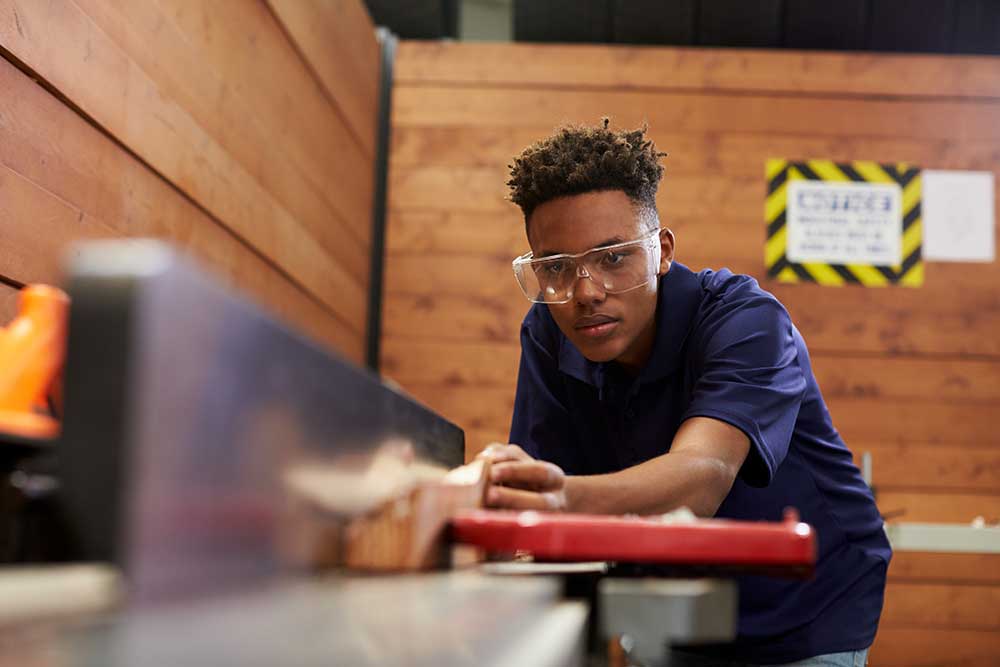Disclaimer: The information on our website is provided for general information purposes only. We make no representations or warranties of any kind, express or implied, about the completeness, accuracy, reliability, suitability or availability with respect to the website or the information contained on our website for any purpose. Any reliance on such information is therefore strictly at your own risk and we are not liable for any damages or losses arising out of or resulting from your reliance on any information contained on our website.
Carpenters can be working on a variety of projects, and there are many specializations within the carpentry industry. When you think of a carpenter, you may also think of someone that works with wood. However, modern carpenters use a variety of materials, and their job duties are also diverse. You can find them providing the framework of a building, crafting cabinets for kitchens and bathrooms, or even completing trim work for various items. Watch a video to learn what a carpenter does.
How to Become a Carpenter

Carpenters typically need a high school diploma or equivalent. Most carpenters learn the trade on the job or through apprenticeship programs. All carpenters must also pass the Occupational Safety and Health Administration (OSHA) safety course. This course can be obtained through your employer, or you can go to the United States Department of Labor directly. They offer both 10 hour or 30-hour Occupational Safety and Health Administration (OSHA) courses.
Though not required, some vocational-technical schools or community colleges also offer associate’s degrees in carpentry. These programs teach the basics, such as reading blueprints, measuring, and different techniques needed for the field. Also, some programs may offer specialties in carpentry.
Carpentry Apprenticeships
While attending a carpentry training program at a technical school or community college, you will also complete an apprenticeship program that usually lasts 3-4 years. During the apprenticeship, you will receive not only specialized training, but also safety, first-aid, and building code requirements. You may also consider looking at national and local unions or contractor associations; they may offer or sponsor apprenticeship programs as well. These programs may require you to be at least 18 years old, hold a high school diploma or the equivalent, be physically fit for the job, be a U.S. citizen or show proof of legal residency, and pass a substance abuse screening. Veterans may receive preferred entry, but it is still worth a look at.; if anything, it is an opportunity to network with people in the industry.
Job Description of a Carpenter
Carpenters’ duties vary depending on the job, but typically, they have the tasks of reading, building, or following blueprints for the job. Carpenters may install windows and molding by measuring, cutting, and shaping materials such as wood or plastic. They may construct frameworks for items like floors, door frames, and walls. A carpenter must level, erect, and install building frameworks by using cranes and rigging hardware. They inspect damaged frameworks or other structures and replace them if necessary. Carpenters at times may oversee and direct construction helpers or those that are learning the trade. Also, they must ensure that all final work is completed according to specifications and project requirements. During the day, they often secure building materials with nails, screws, staples, and tape or laser measures on nearly every project to determine distances and accuracy quickly.
Carpentry Tools and Technology
Carpenters use various hand and power tools throughout the day; these are critical to completing a job properly. These tools include squares, levels, chisels, sanders, circular saws, nail guns, or welding machines. With larger projects or at construction sites, carpenters may have to use rigs or cranes as well. In the preplanning stages, carpenters may also use computers, software, and other technology devices to assist with blueprint plans, drafting, or other mathematical calculations. Many employers require carpenters to supply their own tools on the job.
Safety
Carpenters do wear protective equipment such as boots, hardhats, and other protective gear to prevent injuries. However, due to the physical demands, carpenters can get injured on the job. Injuries can include strains caused by overexertion when moving materials, falls or tripping, or even cuts while using tools. However, precautions and safety measures are always in place to prevent these events from occurring.
Work Environment
Carpenters work at various sites; this can include both indoors and outdoors settings, from installing kitchen cabinets, to building homes, or even frames for city bridges. You have to have good physical stamina and the physical abilities to work in small paces, stand long periods, lift items, and kneel or crouch down. Many carpenter work full time and are self-employed or work for construction companies. Hours include long days, evenings, and weekends due to ensure deadlines are met. Varied weather and extreme temperatures impact building or construction timelines, which in turn dictate what a carpenters’ work hours look like! According to the Labor of Statistics, employment prospects should be good, especially in the construction arena. Prospective carpenters with a set of necessary carpentry tools will have the best candidates.
Benefits of Being a Carpenter
Carpenters find gratification in the hands-on nature of their work, taking pride in constructing tangible, meaningful creations. Witnessing the tangible results of their labor provides deep job satisfaction. The profession offers a consistent stream of opportunities, as the demand for skilled carpenters remains high. Carpenters can enjoy the advantage of cost-saving when building for themselves or friends, ensuring quality craftsmanship. Entrepreneurial-minded carpenters have the option to start their own businesses and become their own bosses. With minimal education and skill requirements, individuals can quickly enter this field, kickstarting their income with minimal investment. Carpenters generally maintain regular working hours and may enjoy some flexibility depending on client needs, adding to the profession’s appeal.
Carpenter Career Video Transcript
From sanding a board perfectly smooth to transforming two by fours into a finished structure, carpentry fills the bill for those who want a hands-on career. Carpenters construct and repair wooden building frameworks and structures such as stairways, door frames, and windows. They use hand and power tools to cut and shape wood, plastic, fiberglass, or drywall. They use a tape measure on nearly every project and need math skills to calculate the proper size for pieces they cut. They also train and direct construction and carpenters helpers.
Carpenters helpers work under carpenters’ direction. Typically, they gather and carry materials, clean work areas and equipment, measure and cut materials, and position equipment. Carpenters and helpers work both indoors and outdoors. Worksites vary from tall buildings and bridges to homes and industrial sites. The work is sometimes strenuous and involves physical risk, requiring protective equipment and safety practices.
Most carpenters learn their trade through a 3 or 4-year apprenticeship program that combines technical training with paid on-the-job training. Apprentices must have a high school diploma or equivalent, have the physical ability to do the work, and meet additional criteria. Carpenter helpers usually learn on the job and have no specific education requirement.
Article Citations
Bureau of Labor Statistics, U.S. Department of Labor, Occupational Outlook Handbook, Carpenters.
National Center for O*NET Development. 47-2031.00. O*NET OnLine.
The career video is Public Domain from the U. S. Department of Labor, Employment and Training Administration.

